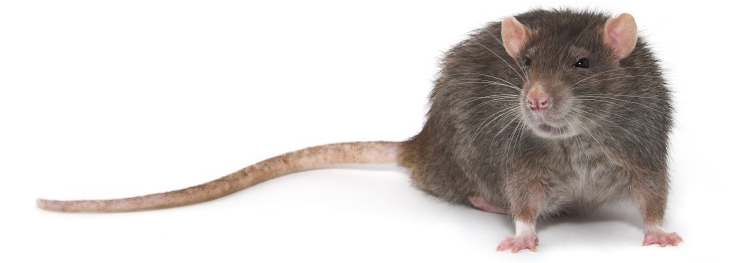Rats

Origins and distribution
Originated in East Asia and spread throughout the world by foot and by ship. It was first recorded arriving in Europe in the beginning of the 18th century. Now present on every continent except Antarctica, often living where humans live.
Characteristics
The brown rat has a slightly shorter tail than its combined head and body length of approximately 20 – 25 cm. It is usually brown or grey in colour with a lighter underbelly with small ears and eyes with a weight of between 300 – 550 grams. It is often shy with a fear of new objects and like mice its peak activity is at night. Brown rats eat an average of 30 – 50 grams of food per day and must drink water daily; approximately 60mls unless its food is has high moisture content.
Breeding
Brown rats can have between 3 – 6 litters per year with a litter size of 7 – 10 young. The life span can be anything up to 18 months with sexual maturity reached at 3 months.
Habits
Brown rats can produce up to 40 droppings a day and often use an area as a latrine. Brown rats are very good climbers often getting into the roof spaces in buildings and are very destructive.
Signs of activity
- Droppings.
- Runs.
- Smear marks.
- Holes and gnaw marks.
- Nests and burrows.
Importance
Rats can cause considerable damage to food and non perishable products and property and if left can breed at an alarming rate. They present a serious risk of disease transmission of infections such as Weil’s disease, hantavirus, salmonella and typhus.
How we control Rats
Our control methods for rats prioritise exclusion as a first alternative such as proofing of holes around pipes, in brickwork and mesh covers over broken or inadequate air vents along with habitat management (clearing away clutter, debris, overgrown bushes etc.). We carry out rodenticide placement which is strategically placed and contained in lockable plastic or metal bait stations where necessary. Rodenticides come in many different formulations such as whole or cut grain, block, pasta or wax bait. These are very palatable and encourage rats to feed and are an anti-coagulant resulting in quick control. These are placed under floor spaces, roof voids, electrical, stair or riser cupboards, plant rooms, kitchens (particularly under cupboard units or behind fridge appliances).
Sometimes due to behavioural resistance, rats may not enter or feed within the bait stations; this is particularly prevalent in inner city environments. In these situations trapping may be required using humane live capture traps (which have to be inspected daily) or fatal capture traps such as the traditional ‘snap’ trap. When using these we place these in strategic, discrete locations out of harm’s way. Depending upon legislative requirements, the environment and infestation levels we are able to tailor the service to the customer needs, this may result in a planned maintenance contract consisting of routine periodical inspections or a short intensive one off treatment.


















